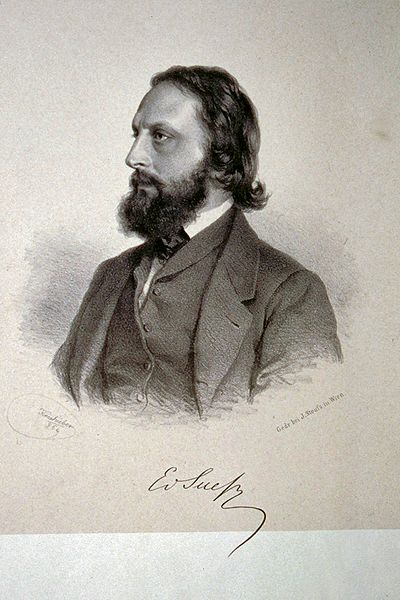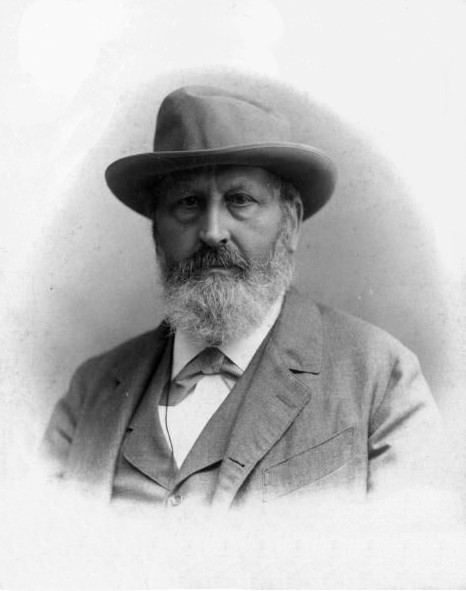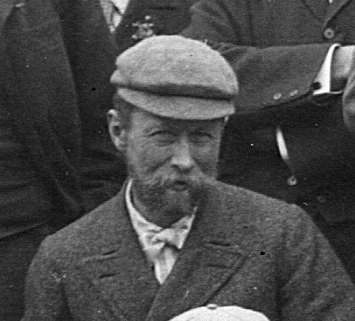<Back to Index>
- Geologist Eduard Suess, 1831
- Geological Engineer Bailey Willis, 1857
PAGE SPONSOR


Eduard Suess (August 20, 1831, London – April 26, 1914, Vienna) was a geologist who was an expert on the geography of the Alps. He is responsible for hypothesizing two major former geographical features, the supercontinent Gondwana (proposed 1861) and the Tethys Ocean.
Born in London to a Lutheran Saxon merchant and his Jewish wife, when he was three his family relocated to Prague, then to Vienna when he was 14. Interested in geology at a young age, he published his first paper (on the geology of Carlsbad, now in the Czech Republic) when he was 19.
By 1857 he was a professor of geology at the University of Vienna, and from there he gradually developed views on the connection between Africa and Europe; eventually he came to the conclusion that the Alps to the north were once at the bottom of an ocean, of which the Mediterranean was a remnant. Suess was not correct; his analysis was predicated upon the notion of "contractionism": the idea that the Earth is cooling down and, therefore, contracting. Nevertheless, he is credited with postulating the earlier existence of the Tethys Ocean, which he named in 1893. He claimed in 1885 that there had once been land bridges connecting South America, Africa, India, Australia and Antarctica. He named this ancient broken continent Gondwanaland.
In volume two of his massive, three volume Das Antlitz der Erde Suess set out his belief that across geologic time, the rise and fall of sea levels were mappable across the earth, that is, that the periods of ocean transgression and regression were correlatable from one continent to another.
His theory was based upon glossopteris fern fossils occurring in South America, Africa and India. His explanation was that the three lands were once connected in a supercontinent, which he named Gondwanaland. Again, this is not quite correct: Suess believed that the oceans flooded the spaces currently between those lands.
Suess is considered one of the early practitioners of ecology. He published a comprehensive synthesis of his ideas in 1885 - 1901, entitled Das Antlitz der Erde
(translated as "The Face of the Earth"), which was a popular textbook
for many years. In this work Suess also introduced the concept of the biosphere, which was later extended by Vladimir I. Vernadsky in 1926.
-
- "... one thing seems to be foreign on this large celestial body consisting of spheres, namely, organic life. But this life is limited to a determined zone at the surface of the lithosphere. The plant, whose deep roots plunge into the soil to feed, and which at the same time rises into the air to breathe, is a good illustration of organic life in the region of interaction between the upper sphere and the lithosphere, and on the surface of continents it is possible to single out an independent biosphere" - Eduard Suess
He was elected a member of the Royal Swedish Academy of Sciences in 1895 and he won the Copley Medal of the Royal Society in 1903.
The crater Suess on the Moon and a crater on Mars are named after him. His son, Franz Eduard Suess (1867 – 1942), was superintendent and geologist at the Imperial Geological Institute in Vienna.

Bailey Willis (March 31, 1857, in Idle Wild - on - Hudson, New York, United States – February 19, 1949, in Palo Alto, California) was a geological engineer who worked for the United States Geological Survey (USGS), and lectured at two prominent American universities. He also played a key role in getting Mount Rainier designated as a national park in 1899. After later focusing more on seismology, he became one of the world's leading earthquake experts of his time.
Bailey Willis was born March 31, 1857, the son of poet and publisher Nathaniel Parker Willis and Cornelia Grinnell Willis. At the age of thirteen he was taken to England and Germany for four years of schooling. and thus acquired fluency in German at a time when many scientific texts were only available in that language. He entered Columbia University and in five years completed his studies with the degrees of mechanical (1878) and civil (1879) engineer.
Willis married his cousin, Miss Altona Grinnell, in 1882, but she died in 1896. The couple had two children, Marion, who died in infancy, and Hope, later Mrs. Seward H. Rathbun. In 1898 he married Margaret Baker, daughter of Dr. Frank Baker of Georgetown University, who was also superintendent of the National Zoo in Washington, D.C.. The children of his second marriage are Cornelius G. Willis, Robin Willis and Margaret (Mrs. Donald F.) Smith. The family lived for many years on the Stanford University campus. Mrs. Willis died in 1941
After receiving degrees in mining engineering and civil engineering, Willis worked from 1881 to 1884 as a survey geologist for Northern Pacific Railroad.
From 1884 to 1915, he worked for the USGS, being named director of the
Appalachian division in 1889. In 1893 he published "The Mechanics of
Appalachian Structure" in the Report of the United States Geological Survey. From 1895 to 1902 he lectured on geology at Johns Hopkins University.
In 1900 he was appointed as head of the Division of Areal Geology of
the USGS. In 1903 he accepted the invitation of the newly established Carnegie Institution of Washington to lead an expedition to northern China, an experience which was later described in his book Friendly China. From 1910 until 1914 he consulted for the government of Argentina
an experience later recorded in his book a Yanqui in Patagonia. He led a
vigorous public campaign in the 1920s to raise awareness of earthquake
hazards and safe building practices.
After finishing his work with the USGS, he was appointed as a professor and chairman of the geology department at Stanford University, where he served until 1922. In 1920, he was elected to the National Academy of the Sciences. He was president of the Seismological Society of America from 1921 to 1926, during which time he published his Geologic Structures. In 1932, he published "Isthmian Links" in the Bulletin of the Geological Society of America. Among the numerous honors which came to Willis during his long life, were an honorary Ph.D. degree from the University of Berlin and the Gold Medal of the Société de Géographie of France in 1910, the Legion of Honor, Belgium, in 1936, and in 1944 he was awarded the Penrose Medal by the Geological Society of America.